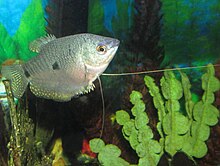Three spot gourami
| Three spot gourami | |
|---|---|
 |
|
| Scientific classification | |
| Kingdom: | Animalia |
| Phylum: | Chordata |
| Class: | Actinopterygii |
| Order: | Perciformes |
| Family: | Osphronemidae |
| Genus: | Trichopodus |
| Species: | T. trichopterus |
| Binomial name | |
|
Trichopodus trichopterus (Pallas, 1770) |
|
| Synonyms | |
|
|
The three spot gourami (Trichopodus trichopterus), also known as the blue gourami, is a species of gourami native to southeastern Asia, but also introduced elsewhere. This fish gets its name from the two spots along each side of its body in line with the eye, considered the third spot. This species is of minor commercial importance as a food fish in its native range and is also farmed. It is also popular in the aquarium trade.
Three spot gourami are native to standing or slow-moving freshwater habitats in southeastern Asia, ranging from Yunnan (China), through mainland southeast Asia (Cambodia, Laos, Malaysia, Myanmar, Singapore, Thailand and Vietnam) to Java, Borneo and Sumatra. They have been widely introduced outside their native range, such as the Philippines, India, Sulawesi, and southwestern Trinidad. These fish live in marshes, swamps, canals, and lowland wetlands. They migrate during the flood season from permanent water bodies to flooded areas, such as seasonally flooded forests in the middle and lower Mekong. During the dry season, they return to these permanent water bodies. These fish feed on zooplankton, crustaceans, and insect larvae. The male builds a bubble nest for the eggs, which he protects aggressively.
...
Wikipedia

